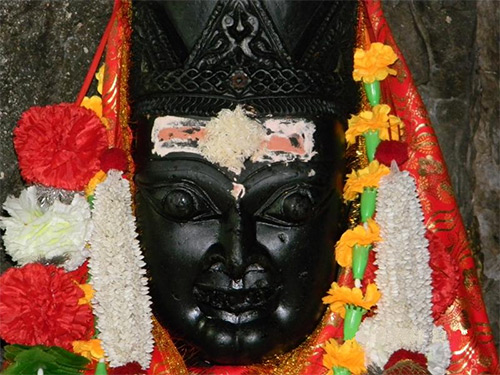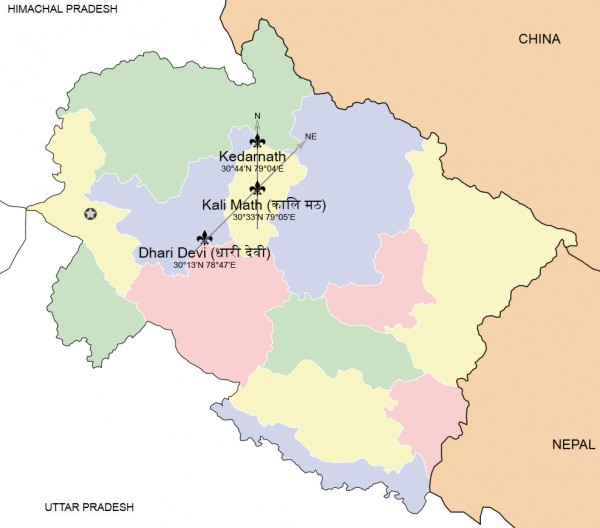
On June 15th, 2013, the ancient deity of Dhari Devi was removed from her temple to be shifted to another location to facilitate the construction of a dam, which locals were opposing ever since the conception of the project with the belief that the moving of the Dhari Devi would somehow agitate Kali. Exactly on the next day a massive cloudburst and flash flood started in Uttarakhand, which devastated Kedarnath, washing the city completely away.
This may sound like a story from a comic book, but it is not so – its reality that most people today like to ignore and push aside as superstition. The fury of the goddess is well known and any attempt to instigate her would lead to great destruction. Let us look at the events leading to the great devastation of Uttarakhand by flooding of Uttar Kashi.
The government has tried to build up dams to overcome the power shortage in the country. This has been opposed by locals and some prominent politicians like Uma Bharti and B. C. Khanduri of the BJP since it would lead to the submergence of the temple of Dhari Devi. As a result efforts to construct dams have been delayed indefinitely. Previously, in 1882, an attempt to shift the Dhari Devi shrine was immediately followed by havoc in Kedar Valley. There is some strange connection between these guardian goddess and the Kedarnath jyotirlinga.
The Joint Temples

These are not just any other Shakti temples, they are among the 108 Shakti Pitha mentioned in the Devi Bhagavat. Dhari Devi is a temple on the banks of the Alakananda River in the Garhwal Region of Uttarakhand state, India. It houses the upper half of a deity of goddess Kali specifically called “Dhari Devī” that, according to local lore, changes in appearance during the day from a girl, to a woman, and then to an old lady. Perched atop a 20 metre high rock, the temple of Dhari Devi is situated on the banks of river Alakananda. One has to travel a distance of 19km from Srinagar (Pauri Garhwal) on Srinagar-Badrinath highway upto Kaliya Saur, then down trek another half a kilometer towards Alakananda river.
According to a local legened, the temple was once washed off by floods, while floating the idol struck against a rock, the villagers heard the cries of the idol. On reaching the site they heard a divine voice instructing them to install the idol as it was, on the spot it was found. Since then the fierce looking idol remains where it was, known as Dhari Devi, under the open sky, and thousands of devotees on the way to Badrinath pay their obeisance to it. The temple of Dhari Devi in Srinagar hosts only the upper part of the deity of Godess Dhari, the remaining lower part is believed to be in Kalimath in Rudraprayag district.
It is believed that the idol of Dhari Devi shall not be put under a roof. For the same reason, the deities in Dhari Devi Temple are put under open sky. Taking photographs of the Dhari Devi deities are strictly prohibited. The village near the temple is name after godess Dhari and known as Dhari Village. A hanging bridge over Alaknanda river connects the Dhari Devi temple to Dhari Village.
Now, the lower half of the idol of Kali is located in Kalimath Temple. These joint temples are aligned exactly at NE-SW direction (see adjoining image) symbolizing Kali as sleeping with her feet in NE direction and head in the SE direction.
This causes the energy to flow in the NE direction, which in jyotiṣa, is the direction of Jupiter (Ishana Shiva), the parameṣṭhi guru. The upper part of the devi with the head symbolizes the calming of Kali by Shiva, the Guru. The lower part of Kali is not in the form of an idol and instead, is worshipped as the Sri Yantra. In this manner we learn that the Sri Yantra, as established by Adi Shankara at Kalimath, is the yoni of Shakti from which all creation proceeds.
The Kedarnath jyotirlinga is exactly North from Kalimath (see adjoining image) symbolising the husband-wife or Shiva-Shakti relationship. In this, Kedarnath being to the north (Mercury direction for ahimsa) is constantly calming the devi who is in the south (Mars direction, anger, agitated and at war).
On June 15th, 2013, the deity of Dhari Devi was removed from her ancient temple to be shifted to another location to facilitate the construction of the same dam (a 330 megawatt hydro electric project which now stands in ruins), which locals were opposing ever since the conception of the project with the belief that the moving of the Dhari Devī would somehow agitate Kali. They were right in their belief as any movement would lead to a change in the angle of the Dhari Devi and Kalimath alignment, besides altering the distance. There are energies we human beings do not understand as yet and it is best to let these spiritual shrines where these energies are contain, be maintained.
With the shifting of Dhari Devi, the agitated Kali has been woken up, and she seeks the demon Raktabija (seed of blood). As per mythology, Raktabija took various bodies and she continued to destroy each one. Primarily this indicates unimaginable bloodshed and death. Exactly on the next day a massive cloudburst and flash flood started in Uttarakhand. Today, when official death figures are at 1,000 (identified people/bodies), the unofficial figure is way beyond 5,000 deaths and more are still following as the rains are returning.
Restore the idol of Dhari Devi (Kali torso) to its original shrine and start the prayers that calm her down. Shri Yantra sadhana has to be maintained at Kalimath and Bael leaf must be offered to Kedarnath. If this is done, then Kali will calm down and the agitation of nature will stop. If this is not done, then the agitation of Kali shall spread throughout India and this will prove to be one of the worst years in the history of modern India.











nice very interesting and well written
Dear Sir, your article is so well written. I wish these greedy politicians undestand that this region is based on a particular kind of worship. all the time they scream secular and destroy the fine fabric of our culture, history. if you go to middleeast countries, their social studies chapter is nothing but islam. but look at us our youngsters they have hardly knowledge about our custom . we can blame none but hindus for this plight .we have become indifferent to our very roots
dear sir,
i have just read your article on havoc in kedarnath but my opinion is different as i don’t believe that kali mata have anything to do with the devastation in kedarnath. i had a dream just 2 days before the devastation in kedarnath in which i saw i was carrying a kalash and accompanied by my father and we were walking on long lonely road covered both side by vegetation when suddenly there was a man wearing a dhoti and riding a wild boar. the man was fieresome and he started following us and we started running. we were running like anything and he was also coming after us over wild boar. i turned around to see the distance between him and us and found that while he was running there was huge wave of water and mud behind him. at a point when i was totally exhausted i called maa loudly and in front of me appeared goddess wearing yellow sari with trishul in one hand and abhay mudra with another hand and from her abhay mudra a rope came and tied across mouth of wild boar and it stopped following us and we went to temple and returned home safely. this is the first time i am sharing this dream on internet as earlier i had only shared it with my parents. from this i came to conclusion that goddess can do any thing but do not cause harm to her devotees. that day something happened but what i cant tell and i dont want to know
hello thank you for your website it is with great joy to know were our culture come from.i hope that round the world people can go to this website site and read this.thank you once again.
this is very true and i frequent visit these place and i know the power/vibrations of Ma Kali.
Ma Kali, Ma Ganga and Lord Shiva are connected, if you try to disturb or spoil the places definitely this type of disasters will happen, and these days most of the outsiders in the form of tourist coming to DEVBHOOMI and spoiling, Himalayan should be treated/used for Sadhana not for Holiday spot
Very nice sir.u r doing great research and great job in promoting scientifically researched facts known to be contained in Indai’s rich scriptures,traditions and customs. Still we have to work hard to make common people understand the scientific and factual reasons behind out traditions
Thank you
Dear Sir, Thank you for this educational article.
Is the Kalimath tempel mentioned in this article Kalimath,
a small villiage also known locally as Kasar Devi,
situated some 7 km outside of Almora town?
Frist of all we need to ask is India a totalairnsim or democratic country only in totalairnsim country the gov will do such thing against the intrest of people while disrespecting the culture.Moving an ancient temple is disrecpectfull this is pure symbolic clutural destruction we can’t expect to advance our country by bending , distorting a or destroying temple.The great way is to advance while emphasising both culture and modernity equally, else truly problematic future.
Oh my god
A nice experience visiting your site, The contents are so energizing, containing our sanskriti,God bless you, thank you
This destruction is caused by sending powerful scalar energies (project haarp) to destroy the immortal siddhas of the region and take over .this is a very big conspiracy done by the secret society illumnati.
I would request the present govt to put back DHARI DEVI back in her original position, and to do the rectification puja .if this new govt wants to survive they should immediately restore Devi ma.i request our PM Modi ji to personally restore this temple on war footing.rgds
The power of Almighty is something that we humans cannot comprehend. The kedarnath floods following the devastation is but the wrath of Kalima. We have no right to replace the idol as it is a swayambhoo.
The Congress government will destroy our Hinduism, our ancient culture, arts and the way of our life. They are nothing but cancer in our country. If we are not united, we will all cease to exist.